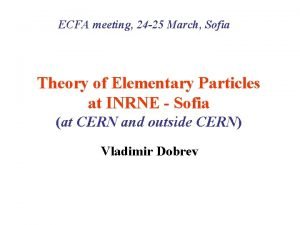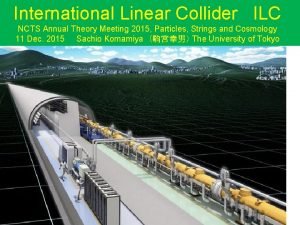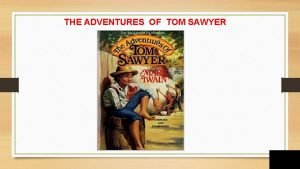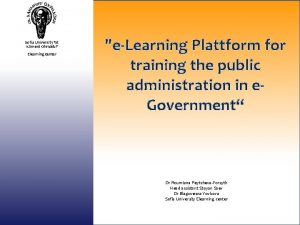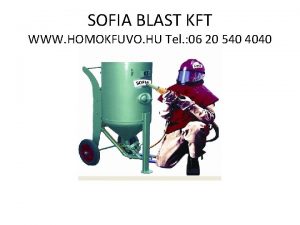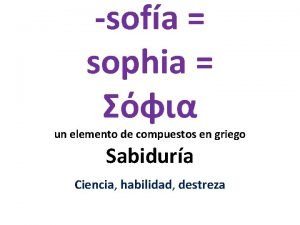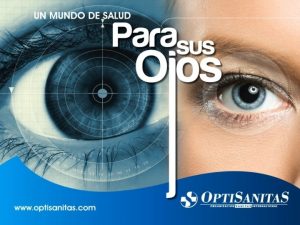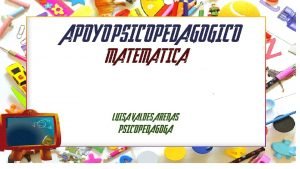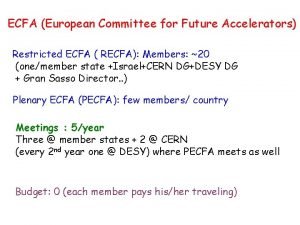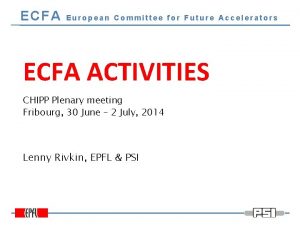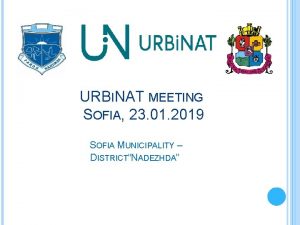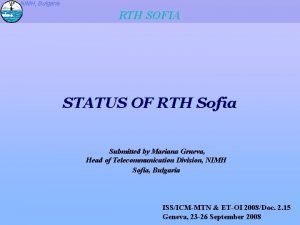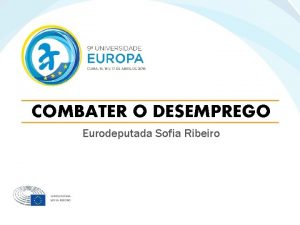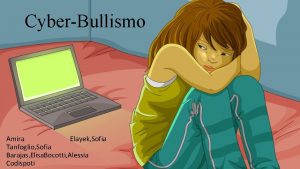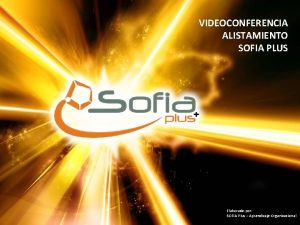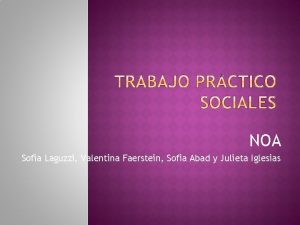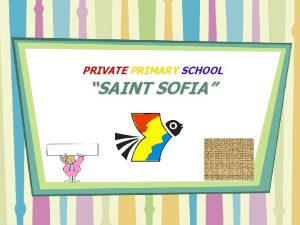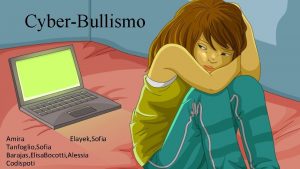ECFA meeting 24 25 March Sofia Theory of


















- Slides: 18

ECFA meeting, 24 -25 March, Sofia Theory of Elementary Particles at INRNE - Sofia (at CERN and outside CERN) Vladimir Dobrev

Laboratory "Theory of Elementary Particles" (TEP) STAFF Head of the Laboratory - Prof. E. Nissimov (Corresponding member of Bulgarian Academy of Sciences - BAS) Permanent positions Professors – 6, (2 of them are Corresponding members of BAS), Associate Professors – 11, Assistant Professors – 4, Junior investigators – 3 (2 of them occupy post doc positions abroad) total - 24 Members of the Laboratory are also the Associate members of the Institute Prof. I. Todorov (retired) and Prof. T. Palev (retired) – both full members of BAS 1 Ph. D student, secretary – 1 year contract

Serious problem – lack of young people 10 members of the laboratory are over 65 years (7 of them in retirement) – 42% of the staff !! Reason – The Laboratory is not attractive to young people mainly because of the low salaries in the Academy (BAS) 235 EUR (the minimal salary in the country) for the position “Junior investigator” and 245 EUR for the next position “Assistant Professor”.

Topics according the research program of the Institute 1) Algebraic and geometric methods in quantum theory. Quantum informatics. 2) Conformal and Superconformal Symmetry in Gauge, Field and String Theory a) Strongly interacting gauge fields b) Conformal and Superconformal Symmetry in Field and String Theory c) Invariant (Deformed) Differential Equations and Non Standard Quantum Groups 3) New Aspects in String Theory and Gravitation a) Generalized Gravity and Nonlinear Gauge Theories with Applications to Elementary Particle Physics and Cosmology b) Gauge/gravity duality and integrability in string theory relevant for the Anti-de-Sitter/conformal-field-theory correspondence

c) Relativistic gravity and astrophysics – exact solutions of Einstein’s equations d) Models and dynamics of rapidly rotating neutron stars e) Electromagnetic spectra of the Kerr black hole 4) Theory and Phenomenology of Elementary Particles and Their Bound States a) Partonic spin content of the nucleon and Quantum Chromodynamics (QCD) b) Physics beyond the Standard Model c) Low energy phenomena in splitting energy levels of atoms and molecules 5) Mathematical modeling in physical phenomena and processes

Remark: The investigations connected with topics (4 c) and (5) are entirely performing by the Laboratory “Mathematical modeling in physics” (Head - Prof. D. Bakalov, 5 associate professors, 3 assistant professors, 1 junior researcher). 3 of the members of this laboratory are involved in the research of topics (2 a), (3 c) and (4 a). Publications In 2016 the scientific results of the two Laboratories are published in 74 (63+11) papers in (mostly) international journals and international conference series, and 1 monograph. In 2016, the papers of the members of both Laboratories have received 624 (551+73) independent citations in international science journals and conference proceedings.

Bulgarian grants The investigations in the laboratory are financially supported by three grants of the Bulgarian National Science Fund (the financial resources in the Institute are mainly for salaries): 1) “New paradigms for the fundamental structure of matter” – 26 members (6 of them from Faculty of Physics, Sofia University) Total amount received: 115, 000 Euro (2015 -2017) 2) “Gauge/Gravity Duality, Black Holes and String Compactifications” – 3 members Total amount: 60, 000 Euro (2017 -2019) 3)“Investigations of the spectra and interactions of atoms and molecules focused on the fundamental characteristics and laws of matter” – 6 members Total amount: 50, 000 Euro (2017 -2019)

Conferences and Symposiums organized by the Laboratory In 2017 the members of the Laboratory “TEP” will be organizing the 10 -th International Symposium "Quantum Theory and Symmetries" incorporating 12 -th International Workshop "Lie Theory and its Applications in Physics", Varna, 19 -25 June 2017. Note that such International Symposiums and Workshops are regularly held in Bulgaria with the help of our Laboratory.

The research in the Laboratory is performed within the framework of a broad international collaboration with leading international academic centers from around the world. COLLABORATION WITH CERN During the last years several members of the Laboratory are regularly visiting the Theoretical Physics Department at CERN. These visits (usually 2 -4 weeks) are realized due to the financial support by TH Division, and particularly from COMPASS collaboration. As mentioned earlier, the financial resources in the Institute are mainly for salaries. Also, the financial resources from the grants are not enough to cover the leaving and travel expenses for such visits.

I. Todorov and N. Nikolov worked during their visits in the Theory Division with the late professor Raymond Stora on position space renormalization. Their results were published in Rev. Math. Phys, 26 (2014). They both contributed (two separate) articles in the memorial volume B 912 (2016) of Nuclear Physics. Todorov is also currently engaged at CERN in a joint project with J. Gracia-Bondia and P. Blanchard on the heritage of Raymond Stora. E. Christova and I. Todorov worked (during their separate visits to CERN) in close contact with Tai Tsun Wu (Harvard University) on the Higgs decay into two photons.

Most CERN-related papers of V. Dobrev are part of the project of systematic construction of invariant differential operators for non-compact semisimple Lie groups and algebras, e. g. , paper finished at CERN and published in JHEP 02 (2013). The current status of the project is presented in the monograph: V. Dobrev, "Invariant Differential Operators, Volume 1: Noncompact Semisimple Lie Algebras and Groups", De Gruyter Studies in Mathematical Physics vol. 35 (De Gruyter, Berlin, 2016). The above project was extended to Quantum Groups and to Superalgebras. Generalized quantum statistics corresponding to mixed systems consisting of parafermions and parabosons were investigated by N. Stoilova (J. Phys. A: Math. Theor. 46 475202 (2013); 48 155202 (2015)). Such systems (with order of statistics p=2) are candidates for particles of dark matter and energy.

Spin physics at high energies: Study of the partonic spin content of the nuleon. Global QCD analysis of the data on polarized inclusive and semi-inclusive deep inelastic lepton-nucleon scattering in order to determine the polarized PDFs (D. Stamenov). Study of the fragmentation functions – key point to extract correctly from the data the quark and anti-quark polarized densities, and especially, to determine the strange quark polarization in the nucleon (E. Christova, D. Stamenov). Active cooperation with the members (F. Kunn, M. Stolarski, A. Kotzinian, Y. Bedfer) of COMPASS collaboration at CERN. Evaluation of the systematic effects in the precision spectroscopy of antiprotonic and pionic helium, aimed at improving the accuracy of the fundamental characteristics of the antiproton and the pion - cooperation of D. Bakalov with the CERN ASACUSA collaboration (Masaki Hori).

Collaboration with other International centers and institutions The scientific research of Laboratory “TEP” is conducted in the framework of intensive collaboration with various academic institutions such as: (a) International centers - Joint Institute of Nuclear Research, Dubna – the collaboration is realized mainly via so called INRNE-JINR projects with a priority financing from JINR (3 projects for 2017) - ICTP and SISSA (Trieste, Italy)

(b) National centers - Austria: Institute of High Energy Physics, Vienna University - Belgium: Ghent University - Brazil: Instituto di Fisica Teorica, Sao Paulo; Universidade Federal do Esprito Santo, Vitoria - France: C. E. A. Saclay (Gif sur Yvette), Institut des Hautes Etudes Scientifiques (Bur sur Yvette); Université de Paris Sud (Orsay), L. A. P. P. (Annecy); Université Paul Sabatier (Toulouse); Université Henri Poincaré (Nancy); Centre de Physique Théorique (Marseille) - Germany: DESY Hamburg, Institutfür Theoretische Physik der Universität Göttingen, Technische Universität Clausthal, Max Planck Institut Für Mathematik (Leipzig), Institut für Theoretische Physik der Universität Hamburg - Ireland: Dublin Institute of Technology - Israel: Ben-Gurion University (Beer-Sheva)

- Italy: Trieste University, Universita di Roma II “Tor Vergata”, INFN, Universita di Milano-Bicocca, Milano - Japan: Osaka Prefecture University - Korea: Ewha University, Seoul - United Kingdom: Imperial College and Kings College (London), University of York, University of Northumbria at Newcastle - USA: Institute of Advanced Studies (Princeton, NJ), MIT (Cambridge, MA), Virginia Polytechnic Institute and State University (Blacksburg, Virginia), Pennsylvania State University (Abington), CLASS 12 Collaboration at Jefferson Laboratory (Newport News, VA), University of Massachusetts (Amherst), University of Delaware (Newark); Michigan University (Ann Arbor), North Carolina State University (Raleigh), University of Cincinnati, Cincinnati.

Interesting investigations in low energy physics (Laboratory of Mathematical modeling in physics) In collaboration with S. Schiller's team from the University of Dusseldorf Calculations of the E 1, E 2, two-photon and forbidden E 1 -transition spectra of the hydrogen molecular ions H 2+, HD+ and D 2+, aimed at: (a) extracting improved accuracy values of fundamental parameters such as the electron-to-proton mass ratio, the fine structure and the Rydberg constants, etc. ; (b) eveloping molecular clocks with precision that exceeds the precision ofthe existing atomic clocks In collaboration with INFN-Italy (the FAMU experiment) Measurement of the hyperfine splitting in the ground state of the muonic hydrogen atom and of the proton Zemach radius, needed to resolve the persisting "proton size puzzle"

Participation (Lab “TEP”) in internationally funded projects (a) Academic exchange agreement between Ben-Gurion University (Israel) and Bulgarian Academy of Sciences (b) Scientific cooperation France - Bulgaria: project "Rila-4" No. 112; project "Rila-01/6" (c) Joint Research Project "Representation theory of Lie (super)algebras and generalized quantum statistic" in the framework of an international collaboration programme between the Research Foundation - Flanders (FWO) (Belgium) and the Bulgarian Academy of Sciences (e) COST Action MP 1210 "The String Theory Universe" (2013 -2017) (d) COST Action MP 1304 "Exploring Fundamental Physics with Compact Stars" (2013 -2017)

(f) COST Action MP 1405 "The Quantum Structure of Spacetime" (QSPACE) (2015 -2019) (g) COST Action CA 15117 "Cosmology and Astrophysics Network for Theoretical Advances and Training Actions" (CANTATA) (2016 -2020) (h) COST Action CA 16104 "Gravitational Waves, Black Holes and Fundamental Physics" (GWniverse) (2017 -2021) (i) COST Action CA 15213 "Theory of Hot Matter and Relativistic Heavy-Ion Collisions" (THOR) (2016 -2020)
 Ecfa symposium
Ecfa symposium Ecfa physics
Ecfa physics Anthem of poland
Anthem of poland Today meeting or today's meeting
Today meeting or today's meeting Meeting objective
Meeting objective What is meeting and types of meeting
What is meeting and types of meeting What is meeting and types of meeting
What is meeting and types of meeting Annual theory meeting
Annual theory meeting Vitosha park hotel sofia
Vitosha park hotel sofia Tom sawyer antagonist
Tom sawyer antagonist Technopolis thessaloniki
Technopolis thessaloniki Elearn st kliment
Elearn st kliment Sofia plus
Sofia plus Anyagok keménysége táblázat
Anyagok keménysége táblázat Sofía griego
Sofía griego Optisanitas reina sofia
Optisanitas reina sofia Danny graymore
Danny graymore Dos hermanas fueron a comprar una cuerda de saltar
Dos hermanas fueron a comprar una cuerda de saltar Sofia el arabi
Sofia el arabi
